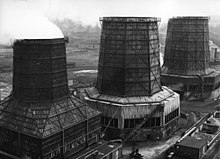Sälzer-Amalie colliery
| Sälzer-Amalie colliery | |||
|---|---|---|---|
| General information about the mine | |||
| Headframe in 2007 | |||
| Mining technology | Underground mining | ||
| Funding / total | 1.2 million t | ||
| Information about the mining company | |||
| Operating company | Friedrich Krupp AG | ||
| Employees | 3400 | ||
| Start of operation | 1934 | ||
| End of operation | 1966 | ||
| Funded raw materials | |||
| Degradation of | Hard coal | ||
| Geographical location | |||
| Coordinates | 51 ° 28 '2 " N , 6 ° 59' 12" E | ||
|
|||
| Location | Altendorf | ||
| local community | eat | ||
| Independent city ( NUTS3 ) | eat | ||
| country | State of North Rhine-Westphalia | ||
| Country | Germany | ||
| District | Ruhr area | ||
The bill Salzer Amalie was a coal - mine in Essen .
history
In 1934 closed the Friedrich Krupp AG mines Eating several newly acquired coal mines to productive composite systems together. In order to avoid shutdowns due to rationalization, the Amalie shaft of the Amalie colliery had been newly sunk in previous years and equipped with a modern conveyor system.
The previously independent collieries ver. Sälzer & Neuack and Amalie became the new colliery Sälzer-Amalie. The Amalie / Marie, Barbara and Huyssen / Schmits pits were added, as well as the Amalie / Marie coking plant and the briquette factory of this pit. The Amalie and Marie pits were responsible for mining . A coking plant in the vicinity of the Huyssen / Schmits mine went directly into the possession of Friedrich Krupp AG and was run independently of the mine in future.
The colliery soon achieved a production of 950,000 t of fat and edible coal with 2,600 employees. During the Second World War , the colliery was badly affected by the bombing raids. This was due, among other things, to the fact that the two double shaft systems were on the edge or within the extensive Krupp factory and were therefore automatically in the main target area of the approaching bombers. From 1943, the neighboring mines Wolfsbank and Christian Levin were taken over by Friedrich Krupp AG . An underground network to the Sälzer-Amalie colliery was established. In 1943, both the coking plant and the Amalie briquette factory had to be shut down. The former Sälzer-Neuack coking plant was destroyed in 1944.
In 1945 the mine had to stop mining completely in order to be repaired. It was not until autumn 1946 that production could start again on a smaller scale. In 1947 a briquette factory was built again on Amalie / Marie. The re-erection of the coking plants was waived because the dismantling and unbundling processes in the Krupp Group at the time made it impossible to foresee how the future of coking coal in the mines would look. Friedrich Krupp AG was converted into a limited liability company following a resolution by the occupation authorities . The mining assets were gradually removed from this group and added to a consortium between Krupp and the Bochumer Verein . He founded subordinate operating companies for the various Kruppzechen. Bergwerke Essen-Rossenray AG was founded in 1953 for the Essener Kruppzechen and the Rossenray union on the left bank of the Rhine .
This began in the mid-1950s with a comprehensive program of consolidation of the Kruppzechen into a central composite mine. In 1954 a funding alliance was established with the Christian Levin mine; the extraction was brought to light with Amalie in the shaft. The Christian Levin 1/2 shafts remained in operation as a cable car system. As the coal crisis worsened, the consolidation measures were further strengthened. In 1960 the Christian Levin construction site was abandoned. The Christian Levin 1/2 shafts remained at the mine as weather shafts, while the Neu Cöln 1 and 2 weather shafts, which also belong to Levin , were filled. The Wolfsbank colliery was connected for management purposes, but was retained as a conveyor system with a coking plant. In 1963 it was decided to join the Helene colliery in Altenessen to Sälzer-Amalie. This took place in 1965 when the Helene production site was abandoned. In 1965, the colliery produced 1.2 million t of coal with 3,400 employees.
Shutdown
Despite the consolidation measures that had already been carried out, it remained to be foreseen that the Sälzer-Amalie colliery would no longer have sufficient economically viable stocks. Therefore, in 1964, the Sälzer-Amalie colliery was registered for the closure of the coal mining rationalization association that coordinated the closures. In 1966 all conveyor systems and the coking plant Zeche Wolfsbank were shut down. The Schacht Amalie briquette factory was shut down in 1967.
literature
- Wilhelm Hermann, Gertrude Hermann: The old mines on the Ruhr. 6th expanded and updated edition, Verlag Karl Robert Langewiesche, successor Hans Köster KG, Königstein i. Taunus, 2006, ISBN 3-7845-6994-3



